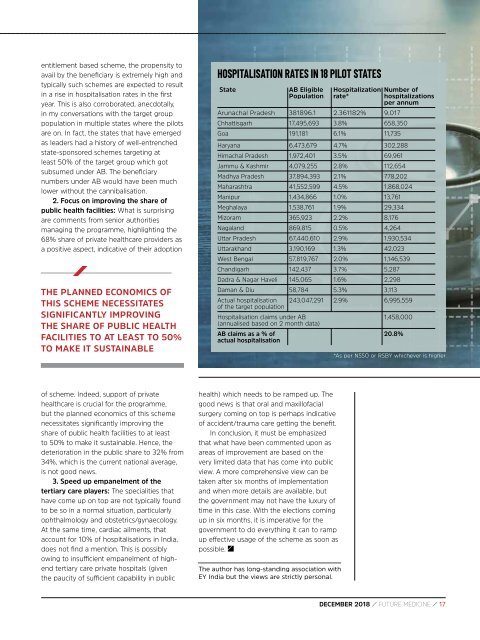FM DECEMBER 2018 ISSUE - digital edition
Create successful ePaper yourself
Turn your PDF publications into a flip-book with our unique Google optimized e-Paper software.
entitlement based scheme, the propensity to<br />
avail by the beneficiary is extremely high and<br />
typically such schemes are expected to result<br />
in a rise in hospitalisation rates in the first<br />
year. This is also corroborated, anecdotally,<br />
in my conversations with the target group<br />
population in multiple states where the pilots<br />
are on. In fact, the states that have emerged<br />
as leaders had a history of well-entrenched<br />
state-sponsored schemes targeting at<br />
least 50% of the target group which got<br />
subsumed under AB. The beneficiary<br />
numbers under AB would have been much<br />
lower without the cannibalisation.<br />
2. Focus on improving the share of<br />
public health facilities: What is surprising<br />
are comments from senior authorities<br />
managing the programme, highlighting the<br />
68% share of private healthcare providers as<br />
a positive aspect, indicative of their adoption<br />
THE PLANNED ECONOMICS OF<br />
THIS SCHEME NECESSITATES<br />
SIGNIFICANTLY IMPROVING<br />
THE SHARE OF PUBLIC HEALTH<br />
FACILITIES TO AT LEAST TO 50%<br />
TO MAKE IT SUSTAINABLE<br />
HOSPITALISATION RATES IN 18 PILOT STATES<br />
State<br />
AB Eligible<br />
Population<br />
Hospitalization<br />
rate*<br />
Arunachal Pradesh 381896.1 2.361182% 9,017<br />
Chhattisgarh 17,495,693 3.8% 658,350<br />
Goa 191,181 6.1% 11,735<br />
Haryana 6,473,679 4.7% 302,288<br />
Himachal Pradesh 1,972,401 3.5% 69,961<br />
Jammu & Kashmir 4,079,255 2.8% 112,654<br />
Madhya Pradesh 37,894,393 2.1% 778,202<br />
Number of<br />
hospitalizations<br />
per annum<br />
Maharashtra 41,552,599 4.5% 1,868,024<br />
Manipur 1,434,866 1.0% 13,761<br />
Meghalaya 1,538,761 1.9% 29,334<br />
Mizoram 365,923 2.2% 8,176<br />
Nagaland 869,815 0.5% 4,264<br />
Uttar Pradesh 67,440,610 2.9% 1,930,534<br />
Uttarakhand 3,190,169 1.3% 42,023<br />
West Bengal 57,819,767 2.0% 1,146,539<br />
Chandigarh 142,437 3.7% 5,287<br />
Dadra & Nagar Haveli 145,065 1.6% 2,298<br />
Daman & Diu 58,784 5.3% 3,113<br />
Actual hospitalisation<br />
of the target population<br />
Hospitalisation claims under AB<br />
(annualised based on 2 month data)<br />
AB claims as a % of<br />
actual hospitalisation<br />
243,047,291 2.9% 6,995,559<br />
1,458,000<br />
20.8%<br />
*As per NSSO or RSBY whichever is higher<br />
of scheme. Indeed, support of private<br />
healthcare is crucial for the programme,<br />
but the planned economics of this scheme<br />
necessitates significantly improving the<br />
share of public health facilities to at least<br />
to 50% to make it sustainable. Hence, the<br />
deterioration in the public share to 32% from<br />
34%, which is the current national average,<br />
is not good news.<br />
3. Speed up empanelment of the<br />
tertiary care players: The specialities that<br />
have come up on top are not typically found<br />
to be so in a normal situation, particularly<br />
ophthalmology and obstetrics/gynaecology.<br />
At the same time, cardiac ailments, that<br />
account for 10% of hospitalisations in India,<br />
does not find a mention. This is possibly<br />
owing to insufficient empanelment of highend<br />
tertiary care private hospitals (given<br />
the paucity of sufficient capability in public<br />
health) which needs to be ramped up. The<br />
good news is that oral and maxillofacial<br />
surgery coming on top is perhaps indicative<br />
of accident/trauma care getting the benefit.<br />
In conclusion, it must be emphasized<br />
that what have been commented upon as<br />
areas of improvement are based on the<br />
very limited data that has come into public<br />
view. A more comprehensive view can be<br />
taken after six months of implementation<br />
and when more details are available, but<br />
the government may not have the luxury of<br />
time in this case. With the elections coming<br />
up in six months, it is imperative for the<br />
government to do everything it can to ramp<br />
up effective usage of the scheme as soon as<br />
possible.<br />
The author has long-standing association with<br />
EY India but the views are strictly personal.<br />
<strong>DECEMBER</strong> <strong>2018</strong> / FUTURE MEDICINE / 17


















